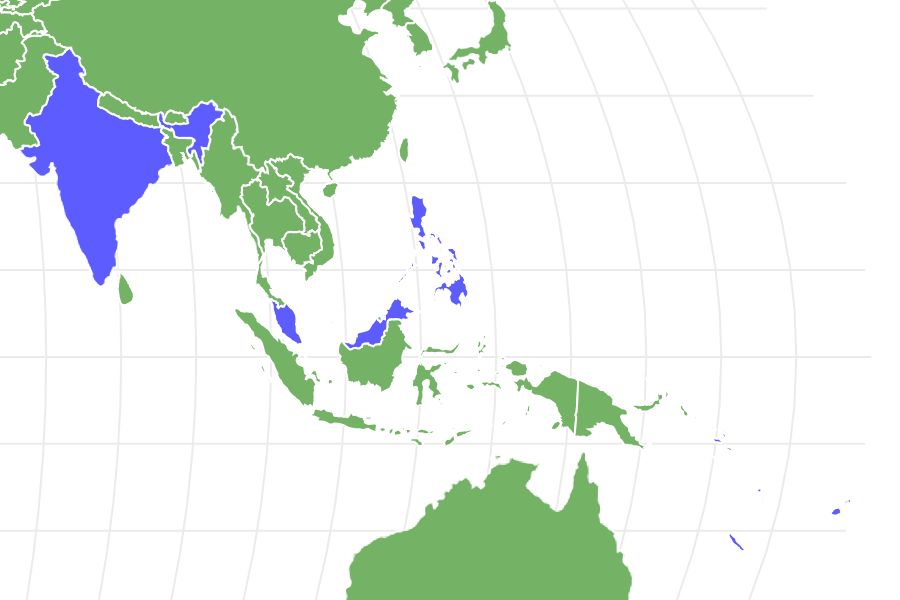Hornbill
Bucerotidae
The bird has a massive horn on its bill!
Advertisement
Hornbill Scientific Classification
- Kingdom
- Animalia
- Phylum
- Chordata
- Class
- Aves
- Order
- Bucerotiformes
- Family
- Bucerotidae
- Scientific Name
- Bucerotidae
Read our Complete Guide to Classification of Animals.
Hornbill Conservation Status
Hornbill Facts
- Prey
- Fruits and insects
- Name Of Young
- Chicks
- Group Behavior
- Flock
- Fun Fact
- The bird has a massive horn on its bill!
- Estimated Population Size
- Varies by species
- Biggest Threat
- Habitat loss
- Most Distinctive Feature
- The large bill and horn
- Gestation Period
- 23-96 days
- Litter Size
- 1-7
- Habitat
- Rainforests, woodlands and savannas
- Predators
- Owls, eagles and humans
- Diet
- Omnivore
- Average Litter Size
- 1-7
- Type
- Bird
- Common Name
- Hornbill
- Number Of Species
- 60
- Location
- The tropical regions of Africa, Asia and the Pacific Islands
View all of the Hornbill images!
The hornbill is a big, brightly colored tropical bird with a long, curved bill, sometimes adorned with an equally elaborate horn on top.
You might say that the hornbill is a bird of charismatic excess and extremes. Its colors, appearance, vocalizations, and social behavior have sometimes drawn comparisons to the equally elaborate toucans of the Americas. But many facts about its anatomy and behavior still remain poorly understood, and we are running out of time to learn about these unique birds, because habitat loss and overhunting have driven many species to the brink of extinction.

4 Incredible Hornbill Facts!
- The hornbill is an arboreal bird that nests in the cavities of large trees. The only exceptions are two species of African ground hornbills: the Abyssinian ground hornbill and the Southern ground hornbill. These species spend most of their time roaming the savanna to consume mice, frogs, snakes, and other meat. When alarmed, they seek respite in ground holes or take to the air.
- Hornbill birds have a very unique kidney structure with two lobes. It is suggested that this might help the bird process water in a highly efficient manner. Scientists have observed that they obtain nearly all of their water from the heavily fruit-based diet.
- Hornbill birds consume between 20% and 33% of their body weight in fruit and meat every single day.
- The rhinoceros hornbill is the national bird of Malaysia.
Scientific Name

There are 60 species of hornbills
©Martin Mecnarowski/Shutterstock.com
The hornbill is a family of birds that goes by the scientific name of Bucerotidae. This is a combination of two Greek words: bous (meaning head of cattle) and keras (meaning horn). If you put the two words together, then you get buceros, which means horns like cattle. This is a reference to the large horn that adorns the head of many species.
This bird’s classification is still a matter of debate. Some taxonomists classify the ground hornbill in its own separate family of Bucorvidae or within the same family as the arboreal hornbills. Another point of dispute is the order to which it belongs. Some taxonomists put hornbills and the closely related hoopoes in the order of Coraciiformes with the kingfishers and bee-eaters. Other taxonomists place them in a separate order called Bucerotiformes. Either way, the facts remain that nearly 60 species are currently recognized. Some of the most well-known include the great, the rhinoceros, the Indian grey, and the African red-billed hornbills. All 60 types of hornbills can be seen below.
Evolution and History
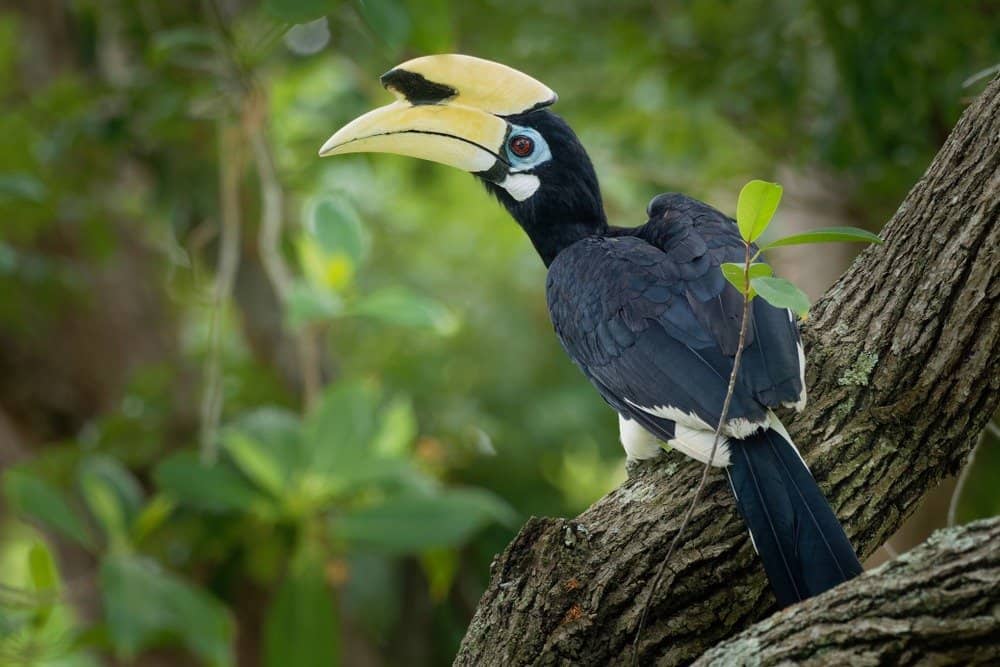
Little is known about the evolutionary history of the hornbill
©Martin Pelanek/Shutterstock.com
The hornbill is a unique bird species that has captured the attention and fascination of many people around the world. However, despite their popularity, little is known about their evolutionary history. Scientists have been studying these birds for decades in an effort to uncover more information about how they came to be.
One theory suggests that hornbills are descendants of ancient birds that lived during the Cretaceous period. These early ancestors were believed to have had long bills and crest-like structures on their heads, which eventually evolved into the distinct features we see in modern-day hornbills today.
Another theory proposes that some of the earliest hornbills may have originated from Africa before spreading out across Asia and other parts of the world over time. This idea is supported by fossil evidence found in Africa dating back millions of years ago.
Despite these theories, much remains unknown about how this fascinating bird species came into existence. Further research and exploration will undoubtedly help shed more light on their evolutionary history and help us better understand these beautiful creatures.
Appearance

Hornbill birds have a large and unique beak with a horn on top
©iStock.com/kajornyot
The hornbill bird has a very unusual appearance that sets it apart from anything else. This includes a large head in proportion to body size with broad wings, prominent eyelashes, and a long tail. The plumage is a brown, grey, or black color mixed in with white markings. This is often combined with a brightly colored arrangement of red, orange, blue, or yellow around the neck or head. Some species will actually enhance the colors of their bills by rubbing them against the preen gland beneath their tails. This has the effect of “dying” the bill a rather bright red or orange color.
By far, the most prominent characteristic is the presence in some species of a large helmet or horn on top of the bill, known as a casque. This structure is composed of keratin, the same substance as nails, hair, and horns. Part of the hornbill’s unusual body shape is due to the fact that two of the neck vertebrae are fused together to support the enormous weight of the head, bill, and casque.
The hornbill ranges in size between 19 inches and 63 inches. The southern ground hornbill is the largest species in the family, with some individuals reaching up to 13.6 pounds. The lightest is the red-billed dwarf hornbill. The female of this species weighs a mere 3 to 4 ounces. The helmeted hornbill of Borneo takes the crown for the heaviest casque in relation to body size. It makes up a full 10% of the bird’s total weight. In most species, the female has a much smaller casque and body size compared to the male.
Behavior

Hornbills are very verbally communicative.
©Sunti/Shutterstock.com
The hornbill is a very noisy bird that announces its presence with a diverse range of calls, including bellows, cackles, and brays. It is believed that the casque is a hollow chamber that serves the purpose of amplifying the sound of the voice. The deep, booming sound this creates is sometimes mistaken for the voice of a lion. Their wings also make a loud chuffing noise while in flight.
Because the male tends to have a larger casque, it is believed that the horn may serve a secondary role as an important sexual signal in the breeding season. The size and brightness of the casque is a mark of health and vitality to other hornbills. In some species, males fight by “jousting” with their bills in the air.
The hornbill is a social animal that gathers in large flocks for protection, mating, foraging, and hunting opportunities. These flocks sometimes consist of more than 100 individuals. Hornbills rise with the sun and begin the day by preening or calling to their neighbors. Then they leave the nest to forage for food in pairs or small groups. Self-care is an important aspect of its behavior. Several species have a specialized preening gland that produces an oily secretion to assist with cleaning. The hornbill will also run its bill against a branch or bark to clean it.
Some hornbills have a reciprocal relationship with other species. The eastern yellow-billed hornbill will work with the dwarf mongoose to gather food. It will keep a lookout for potential predators while the mongoose stirs up insects for the bird to consume.
Habitat
The hornbill is a tropical bird that resides in much of sub-Saharan Africa, India, the Philippines, and the Solomon Islands. The preferred habitat of the arboreal hornbills includes rainforests and woodlands, while the ground-based hornbills largely reside in the open savannas.
Population
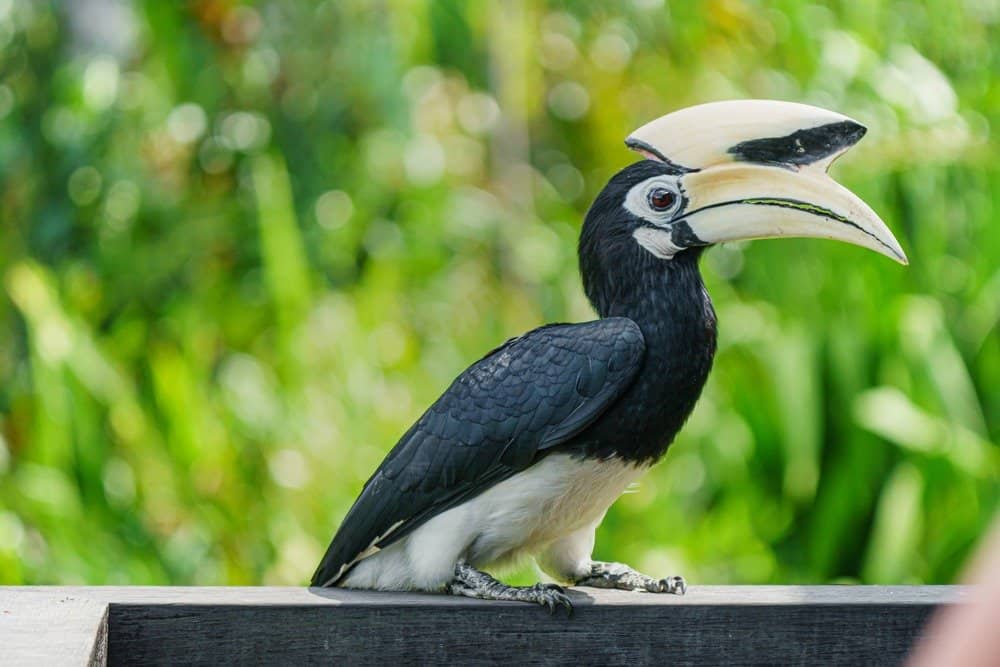
Some species of hornbill are critically endangered.
©BorneoRimbawan/Shutterstock.com
According to the IUCN Red List, population numbers appear to be in sharp decline across the entire family. This ranges between the critically endangered Rufous-headed hornbill, which has no more than 2,500 mature individuals remaining in the wild, and the vulnerable great hornbill, which has 13,000 to 27,000 mature individuals left. On the more positive side of the spectrum, the red-billed hornbill of Africa and the Indian grey hornbill are both species of least concern.
In order to rehabilitate numbers, governments, and conservation organizations will need to work together to protect existing habitats and curtail illegal hunting. Some organizations are also rearing hornbills in captivity to bolster numbers.
Diet
The hornbill is an omnivorous bird that feasts almost exclusively on fruit, insects, or other small animals. The bill has the ability to pluck fruit from the trees, and the end of the bill has sharp notches for tearing apart food. Their bodies are also very efficient at extracting limited proteins from fruit.
Predators and Threats
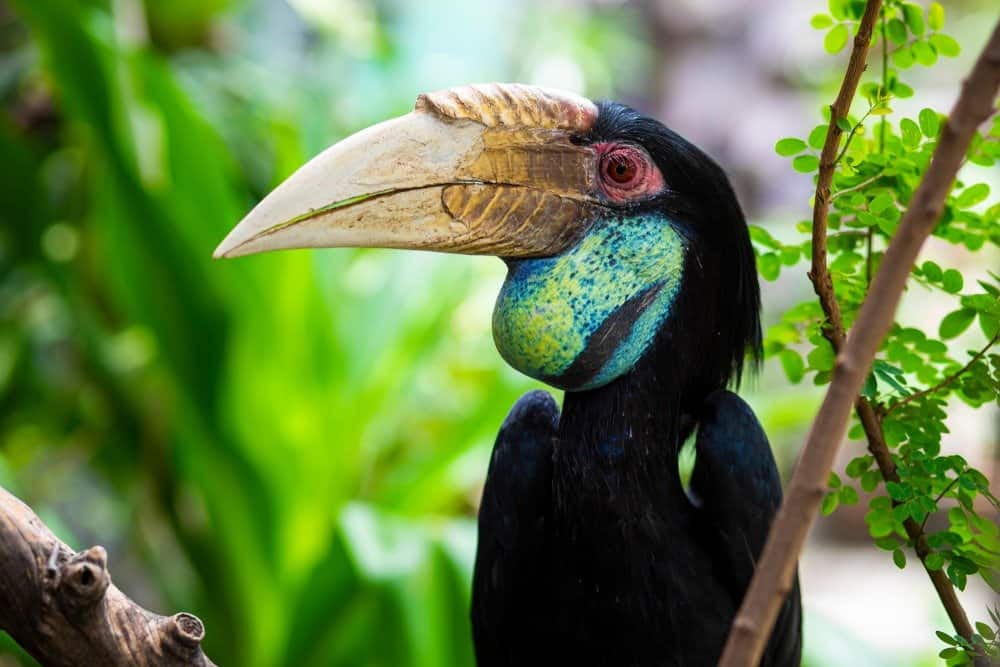
Hornbills have to watch out for eagles.
©ONGUSHI/Shutterstock.com
The hornbill is constantly on the lookout for surprise attacks by birds of prey (in particular, the eagle and owl). It is usually well-protected in the middle layers of the canopy from climbing predators below and aerial predators above. However, habitat loss from logging and agriculture is a serious threat to the hornbill’s survival because most species depend on the trees for all of their needs. Humans have traditionally hunted the hornbill for meat and medicine, but more recently, the intensity of hunting has increased because the casques are incredibly valuable on the international market.
Reproduction, Babies, and Lifespan
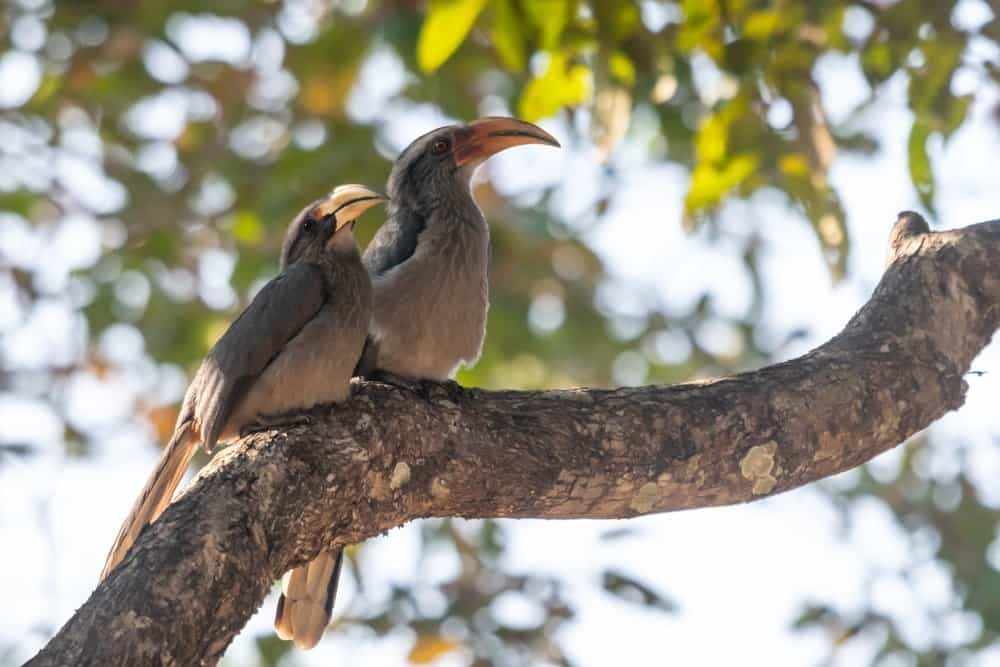
Hornbills mate for life.
©DSLR Shooter/Shutterstock.com
This is a monogamous species of bird that pairs up with a single mate for most of their remaining lives. Because of the intense nature of their relationship, the pair’s courtship is no simple or expendable fling. It involves a complicated set of ritualistic behaviors such as bill contact, vocalizations, and playful chasing. The male also brings food to his mate throughout the year as a demonstration of his commitment to the relationship. The number of offspring they produce together depends on the size of the bird. Smaller species can produce up to seven eggs at a time, while larger species produce only one or two.
The female lays the eggs several days apart, creating a staggered pattern to their hatching. She is quite vulnerable during this time because her molting renders her unable to fly. However, the male has the amazing ability to protect the mother and the chicks by covering the cavity with walls of mud. It will then pass food to the female through a small hole in the wall while she is incubating the eggs. The only type that does not engage in this behavior is the ground hornbills, which nest in unsealed holes, logs, or rock faces on the ground.
The mother will incubate the eggs for 23 to 96 days. When the eggs finally hatch, she will emerge from the mud-covered hole and leave her offspring behind. These tiny chicks (which weigh no more than a few ounces, even in the largest species) will compete with each other for limited food resources. The oldest sibling has the best chance of surviving, while the other siblings are sometimes left to starve. While this may seem like a cruel strategy, it does ensure there are backup chicks in case the oldest one dies.
It can take up to six years before the hornbill reaches full sexual maturity (smaller species reach sexual maturity much faster). The life expectancy of the hornbill is up to 40 years in the wild, but it can survive even longer in captivity.
Hornbills in the Zoo

Oriental Pied Hornbills can be seen in several zoos.
©Millie Bond – Copyright A-Z Animals
This species is one of the most popular tropical bird exhibits in the United States. The San Diego Zoo has a long history with the hornbill that stretches all the way back to 1951. Between the zoo and the safari park, it now claims to house almost 30 species and has hatched more than 520 chicks.
If you don’t live in the San Diego area, then there are still plenty of opportunities to see this magnificent bird in person. The Saint Louis Zoo, San Francisco Zoo, and the Denver Zoo are home to the aptly named great hornbill of Southeast Asia. The Indianapolis Zoo contains both an eastern yellow-billed hornbill and a southern ground hornbill, while Zoo Atlanta also has a southern ground hornbill. The Nashville Zoo, Minnesota Zoo, and Zoo New England are all participants of the Rhinoceros Hornbill Species Survival Plan, which is committed to the survival and rehabilitation of the species. Finally, the Smithsonian’s National Zoo has an Abyssinian ground hornbill, and Zoo Tampa has various hornbill species in its aviary.
60 Types of Hornbills

There are 60 species of hornbills listed below.
©miroslav chytil/Shutterstock.com
| 60 Types of Hornbill Birds |
|---|
| Western red-billed hornbill (Tockus kempi) |
| Northern red-billed hornbill (Tockus erythrorhynchus) |
| Tanzanian red-billed hornbill (Tockus ruahae) |
| Southern red-billed hornbill (Tockus rufirostris) |
| Damara red-billed hornbill (Tockus damarensis) |
| Monteiro’s hornbill (Tockus monteiri) |
| Von der Decken’s hornbill (Tockus deckeni) |
| Jackson’s hornbill (Tockus jacksoni) |
| Southern yellow-billed hornbill (Tockus leucomelas) |
| Eastern yellow-billed hornbill (Tockus flavirostris) |
| Bradfield’s hornbill (Lophoceros bradfieldi) |
| Crowned hornbill (Lophoceros alboterminatus) |
| Red-billed dwarf hornbill (Lophoceros camurus) |
| Hemprich’s hornbill (Lophoceros hemprichii) |
| African pied hornbill (Lophoceros fasciatus) |
| African grey hornbill (Lophoceros nasutus) |
| Pale-billed hornbill (Lophoceros pallidirostris) |
| White-crested hornbill (Horizocerus albocristatus) |
| Black dwarf hornbill (Horizocerus hartlaubi) |
| White-crowned hornbill (Berenicornis comatus) |
| Piping hornbill (Bycanistes fistulator) |
| Trumpeter hornbill (Bycanistes bucinator) |
| White-thighed hornbill (Bycanistes albotibialis) |
| Brown-cheeked hornbill (Bycanistes cylindricus) |
| Black-and-white-casqued hornbill (Bycanistes subcylindricus) |
| Silvery-cheeked hornbill (Bycanistes brevis) |
| Black-casqued wattled hornbill (Ceratogymna atrata) |
| Yellow-casqued wattled hornbill (Ceratogymna elata) |
| Rhinoceros hornbill (Buceros rhinoceros) |
| Great hornbill (Buceros bicornis) |
| Rufous hornbill (Buceros hydrocorax) |
| Helmeted hornbill (Rhinoplax vigil) |
| Tickell’s brown hornbill (Anorrhinus tickelli) |
| Austen’s brown hornbill (Anorrhinus austeni) |
| Bushy-crested hornbill (Anorrhinus galeritus) |
| Sri Lanka grey hornbill (Ocyceros gingalensis) |
| Malabar grey hornbill (Ocyceros griseus) |
| Indian grey hornbill (Ocyceros biostris) |
| Palawan hornbill (Anthracoceros marchei) |
| Oriental pied hornbill (Anthracoceros albirostris) |
| Malabar pied hornbill (Anthracoceros coronatus) |
| Sulu hornbill (Anthracoceros montani) |
| Black hornbill (Anthracoceros malayanus) |
| Rufous-necked hornbill (Aceros nipalensis) |
| Rufous-headed hornbill (Rhabdotorrhinus waldeni) |
| Writhed hornbill (Rhabdotorrhinus leucocephalus) |
| Sulawesi hornbill (Rhabdotorrhinus exarhatus) |
| Wrinkled hornbill (Rhabdotorrhinus corrugatus) |
| Luzon hornbill (Penelopides manillae) |
| Mindoro hornbill (Penelopides mindorensis) |
| Mindanao hornbill (Penelopides affinis) |
| Samar hornbill (Penelopides samarensis) |
| Visayan hornbill (Penelopides panini) |
| Papuan hornbill (Rhyticeros plicatus) |
| Narcondam hornbill (Rhyticeros narcondami) |
| Plain-pouched hornbill (Rhyticeros subruficollis) |
| Wreathed hornbill (Rhyticeros undulatus) |
| Sumba hornbill (Rhyticeros everetti) |
| Knobbed hornbill (Rhyticeros cassidix) |
Hornbill FAQs (Frequently Asked Questions)
What is a hornbill?
The hornbill is a family of tropical birds that reside almost exclusively in trees (except for a few ground-based species). The massive head, bill, and horn are all common features of this family. It includes both African and Asian varieties.
Are hornbills dangerous?
Hornbills pose no known danger to humans. If disturbed, they prefer to run away.
Can hornbills fly?
Every species of hornbill is capable of flight, even the ground-based hornbills.
How many hornbills are left in the world?
Population estimates tend to range between a few thousand and tens of thousands of mature individuals per species.
What is the lifespan of a hornbill?
The typical hornbill can live up to 40 years in the wild and even longer in captivity.
Are Hornbills herbivores, carnivores, or omnivores?
Hornbills are Omnivores, meaning they eat both plants and other animals.
What Kingdom do Hornbills belong to?
Hornbills belong to the Kingdom Animalia.
What phylum do Hornbills belong to?
Hornbills belong to the phylum Chordata.
What class do Hornbills belong to?
Hornbills belong to the class Aves.
What family do Hornbills belong to?
Hornbills belong to the family Bucerotidae.
What order to Hornbills belong to?
Hornbills belong to order Bucerotiformes.
What type of covering do Hornbills have?
Hornbills are covered in Feathers.
Where do Hornbills live?
Hornbills live in the tropical regions of Africa, Asia, and the Pacific Islands.
In what type of habitat do Hornbills live?
Hornbills live in rainforests, woodlands, and savannas.
What are some predators of Hornbills?
Predators of Hornbills include owls, eagles, and humans.
What is the average litter size for a Hornbill?
The average litter size for a Hornbill is between 1 and 7.
What is the scientific name for the Hornbill?
The scientific name for the Hornbill is Bucerotidae.
How many species of Hornbill are there?
There are 60 species of Hornbill.
What is a baby Hornbill called?
A baby Hornbill is called a chick.
What is the biggest threat to the Hornbill?
The biggest threat to Hornbills is habitat loss.
How do Hornbills have babies?
Hornbills lay eggs.
Thank you for reading! Have some feedback for us? Contact the AZ Animals editorial team.
Sources
- Brittanica, Available here: https://www.britannica.com/animal/hornbill
- San Diego Zoo, Available here: https://animals.sandiegozoo.org/animals/hornbill
- Scientific American (1970) https://blogs.scientificamerican.com/tetrapod-zoology/the-splendid-and-remarkable-anatomy-of-hornbills/ Jump to top

